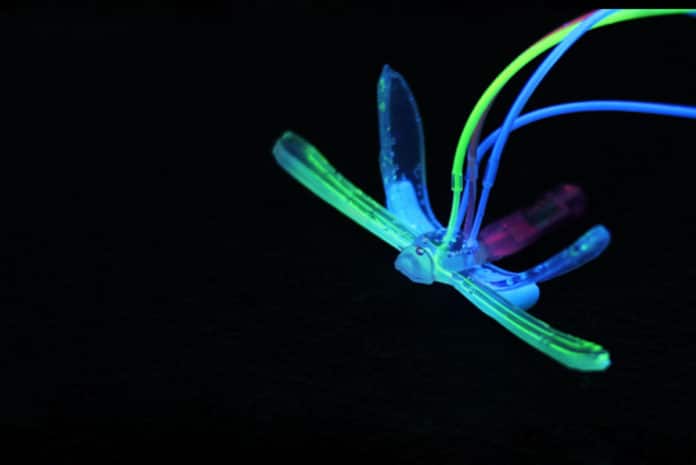Duke University engineers have developed an electronics-free, entirely soft robot shaped like a dragonfly that can skim across water. Called DraBot, the robot has the ability to react to environmental conditions such as pH, temperature, or the presence of oil.
DraBot – about 2.25 inches long with a 1.4-inch wingspan – is still in its proof-of-concept stages but could be the precursor to more advanced, autonomous, long-range environmental sentinels for monitoring a wide range of potential telltale signs of problems.
DraBot works by controlling the air pressure coming into its wings. Inside there is a network of microchannels connected to a flexible silicone tube that carries the air into the front wings of the robot, where it escapes through a series of holes pointed directly into the back wings. When both back wings are down, the airflow is blocked, and DraBot remains stationary, but it moves forward when the wings are up.
To add an element of control, the team also designed balloon actuators under each of the back wings close to DraBot’s body. When they’re inflated, the balloons cause the wings to curl upwards, and by changing which wings are up and down, the engineers move DraBot in their desired direction.
“We were happy when we were able to control DraBot, but it’s based on living things,” said Vardhman Kumar, a Ph.D. student in Varghese’s laboratory. “And living things don’t just move around on their own; they react to their environment.“
To equip the new robot and make it suitable for environmental monitoring, the team turned to a self-healing hydrogel that scientists created during a previous research project. The material reacts to changes in pH by forming new bonds within itself. The bonds are completely reversible when the pH returns to its original levels.
They coated two of the DraBot’s wings with hydrogel, which makes one front wing and one back wing fuse together when it enters highly acidic water. This means that when DraBot encounters higher pH levels, it spins in a circle rather than moving in a straight line. When the pH returns to normal, the fused wings separate, and the DraBot once again becomes fully responsive to commands.
The team also added sponges to the DraBot construction and coated its wings with heat-sensitive materials. When it moves through the water and hits the oil on the surface, the sponges will soak it up and change color to the corresponding color of the oil. And when the water becomes overly warm, DraBot’s wings change from red to yellow.
Responsiveness to pH can detect freshwater acidification, which is a serious environmental problem affecting several geologically-sensitive regions. The ability to soak up oils makes such long-distance skimming robots ideal for the early detection of oil spills.
But this is not the end – the team hopes to bring a number of improvements to their proof-of-concept. Wireless cameras or solid-state sensors could enhance the capabilities of DraBot. And creating a form of onboard propellant would help similar bots break free of their tubing.
